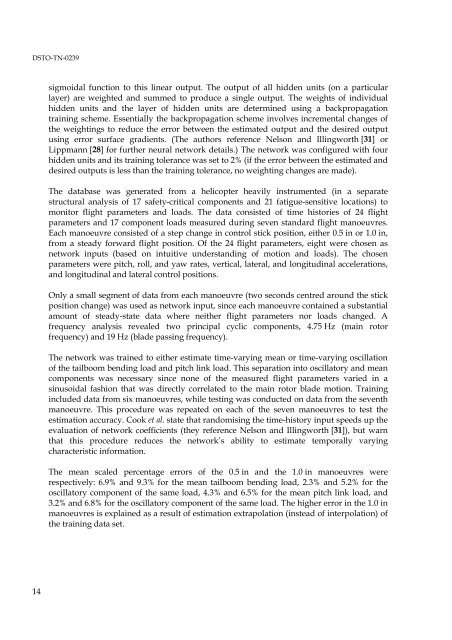Estimation of Structural Component Loads in Helicopters: A Review ...
Estimation of Structural Component Loads in Helicopters: A Review ...
Estimation of Structural Component Loads in Helicopters: A Review ...
You also want an ePaper? Increase the reach of your titles
YUMPU automatically turns print PDFs into web optimized ePapers that Google loves.
DSTO-TN-0239sigmoidal function to this l<strong>in</strong>ear output. The output <strong>of</strong> all hidden units (on a particularlayer) are weighted and summed to produce a s<strong>in</strong>gle output. The weights <strong>of</strong> <strong>in</strong>dividualhidden units and the layer <strong>of</strong> hidden units are determ<strong>in</strong>ed us<strong>in</strong>g a backpropagationtra<strong>in</strong><strong>in</strong>g scheme. Essentially the backpropagation scheme <strong>in</strong>volves <strong>in</strong>cremental changes <strong>of</strong>the weight<strong>in</strong>gs to reduce the error between the estimated output and the desired outputus<strong>in</strong>g error surface gradients. (The authors reference Nelson and Ill<strong>in</strong>gworth [31] orLippmann [28] for further neural network details.) The network was configured with fourhidden units and its tra<strong>in</strong><strong>in</strong>g tolerance was set to 2% (if the error between the estimated anddesired outputs is less than the tra<strong>in</strong><strong>in</strong>g tolerance, no weight<strong>in</strong>g changes are made).The database was generated from a helicopter heavily <strong>in</strong>strumented (<strong>in</strong> a separatestructural analysis <strong>of</strong> 17 safety-critical components and 21 fatigue-sensitive locations) tomonitor flight parameters and loads. The data consisted <strong>of</strong> time histories <strong>of</strong> 24 flightparameters and 17 component loads measured dur<strong>in</strong>g seven standard flight manoeuvres.Each manoeuvre consisted <strong>of</strong> a step change <strong>in</strong> control stick position, either 0.5 <strong>in</strong> or 1.0 <strong>in</strong>,from a steady forward flight position. Of the 24 flight parameters, eight were chosen asnetwork <strong>in</strong>puts (based on <strong>in</strong>tuitive understand<strong>in</strong>g <strong>of</strong> motion and loads). The chosenparameters were pitch, roll, and yaw rates, vertical, lateral, and longitud<strong>in</strong>al accelerations,and longitud<strong>in</strong>al and lateral control positions.Only a small segment <strong>of</strong> data from each manoeuvre (two seconds centred around the stickposition change) was used as network <strong>in</strong>put, s<strong>in</strong>ce each manoeuvre conta<strong>in</strong>ed a substantialamount <strong>of</strong> steady-state data where neither flight parameters nor loads changed. Afrequency analysis revealed two pr<strong>in</strong>cipal cyclic components, 4.75 Hz (ma<strong>in</strong> rotorfrequency) and 19 Hz (blade pass<strong>in</strong>g frequency).The network was tra<strong>in</strong>ed to either estimate time-vary<strong>in</strong>g mean or time-vary<strong>in</strong>g oscillation<strong>of</strong> the tailboom bend<strong>in</strong>g load and pitch l<strong>in</strong>k load. This separation <strong>in</strong>to oscillatory and meancomponents was necessary s<strong>in</strong>ce none <strong>of</strong> the measured flight parameters varied <strong>in</strong> as<strong>in</strong>usoidal fashion that was directly correlated to the ma<strong>in</strong> rotor blade motion. Tra<strong>in</strong><strong>in</strong>g<strong>in</strong>cluded data from six manoeuvres, while test<strong>in</strong>g was conducted on data from the seventhmanoeuvre. This procedure was repeated on each <strong>of</strong> the seven manoeuvres to test theestimation accuracy. Cook et al. state that randomis<strong>in</strong>g the time-history <strong>in</strong>put speeds up theevaluation <strong>of</strong> network coefficients (they reference Nelson and Ill<strong>in</strong>gworth [31]), but warnthat this procedure reduces the network’s ability to estimate temporally vary<strong>in</strong>gcharacteristic <strong>in</strong>formation.The mean scaled percentage errors <strong>of</strong> the 0.5 <strong>in</strong> and the 1.0 <strong>in</strong> manoeuvres wererespectively: 6.9% and 9.3% for the mean tailboom bend<strong>in</strong>g load, 2.3% and 5.2% for theoscillatory component <strong>of</strong> the same load, 4.3% and 6.5% for the mean pitch l<strong>in</strong>k load, and3.2% and 6.8% for the oscillatory component <strong>of</strong> the same load. The higher error <strong>in</strong> the 1.0 <strong>in</strong>manoeuvres is expla<strong>in</strong>ed as a result <strong>of</strong> estimation extrapolation (<strong>in</strong>stead <strong>of</strong> <strong>in</strong>terpolation) <strong>of</strong>the tra<strong>in</strong><strong>in</strong>g data set.14
















